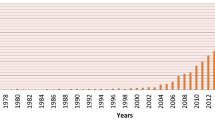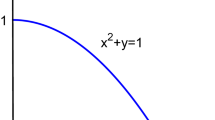Abstract
For the decision-making problems based on decision makers’ judgments in terms of linguistic terms, we propose type-2 fuzzy numbers (T2FNs) that allow decision makers better formalize their judgments. A T2FN has two components: a primary membership and a secondary membership. Compared with T1FSs and interval type-2 fuzzy sets, T2FNs consider an additional dimension by introducing the secondary membership. The primary membership indicates the truth degree of judgment, and the secondary membership further indicates the reliability degree of the truth. We define simple operation rules on T2FNs such that they can be easily used to deal with decision-making problems, such as multi-criteria decision making and multi-stages decision making. Compared with existing related approaches, we verify our approach with several numerical examples.










Similar content being viewed by others
References
Ando, T., Li, C.-K., & Mathias, R. (2004). Geometric means. Linear Algebra and Its Applications, 385, 305–334.
Beliakov, G., Pradera, A., & Calvo, T. (2007). Aggregation functions: A guide for practitioners. Springer.
Bibby, J. (1974). Axiomatisations of the average and a further generalisation of monotonic sequences. Glasgow Mathematical Journal, 15, 63–65.
Chen, S. J., & Chen, S. M. (2008). Fuzzy risk analysis based on measures of similarity between interval-valued fuzzy numbers. Computers & Mathematics with Applications, 55, 1670–1685.
Chen, S. M., & Hong, J. A. (2012). Fuzzy multiple attributes group decision-making based on ranking interval type-2 fuzzy sets and the topsis method. Expert Systems with Applications an International Journal, 39, 5295–5308.
Chen, S. M., & Lee, L. W. (2010). Fuzzy multiple attributes group decision-making based on the ranking values and the arithmetic operations of interval type-2 fuzzy sets. Expert Systems with Applications, 37, 824–833.
Evans, J. S. B. (1984). Heuristic and analytic processes in reasoning. British Journal of Psychology, 75, 451–468.
Evans, J. S. B. (2003). In two minds: Dual-process accounts of reasoning. Trends in Cognitive Sciences, 7, 454–459.
Evans, J. S. B. (2008). Dual-processing accounts of reasoning, judgment, and social cognition. Annual Review of Psychology, 59, 255–278.
Herrera, F., & Martinez, L. (2000). A 2-tuple fuzzy linguistic representation model for computing with words. IEEE Transactions on Fuzzy Systems, 8, 746–752.
Herrera, F., & Martínez, L. (2000). A 2-tuple fuzzy linguistic representation model for computing with words. IEEE Transactions on Fuzzy Systems, 8, 746–752.
Kacprzyk, J. (1986). Group decision making with a fuzzy linguistic majority. Fuzzy Sets & Systems, 18, 105–118.
Kahneman, D., & Frederick, S. (2002). Representativeness revisited: Attribute substitution in intuitive judgment. In Heuristics biases: The psychology of intuitive judgment. Cambridge University Press.
Klein, G. A. (2017). Sources of power: How people make decisions. MIT Press.
Klir, G. J., & Yuan, B. (1995). Fuzzy sets and fuzzy logic. Prentice Hall.
Liu, P., Gao, H., & Ma, J. (2019). Novel green supplier selection method by combining quality function deployment with partitioned bonferroni mean operator in interval type-2 fuzzy environment. Information Sciences, 490, 292–316.
Mendel, J. M., & John, R. B. (2002). Type-2 fuzzy sets made simple. IEEE Transactions on Fuzzy Systems, 10, 117–127.
Ren, P., Zhu, B., & Xu, Z. (2018). Assessment of the impact of hydropower stations on the environment with a hesitant fuzzy linguistic hyperplane-consistency programming method. IEEE Transactions on Fuzzy Systems, 26, 2981–2992.
Tian, Z., Nie, R., & Wang, J. (2019). Social network analysis-based consensus-supporting framework for large-scale group decision-making with incomplete interval type-2 fuzzy information. Information Sciences, 502, 446–471.
Wang, W., Liu, X., & Qin, Y. (2012). Multi-attribute group decision making models under interval type-2 fuzzy environment. Knowledge-Based Systems, 30, 121–128.
Wei, S.-H., & Chen, S.-M. (2009). Fuzzy risk analysis based on interval-valued fuzzy numbers. Expert Systems with Applications, 36, 2285–2299.
Zadeh, L. A. (1965). Fuzzy sets. Information and Control, 8, 338–353.
Zadeh, L. A. (1974). The concept of a linguistic variable and its application to approximate reasoning. Springer.
Acknowledgements
The authors are grateful to the anonymous reviewers for their constructive and detailed comments on the manuscript. This study was supported by the Beijing Municipal Natural Science Foundation (No. M21025). This support is gratefully acknowledged.
Author information
Authors and Affiliations
Corresponding authors
Additional information
Publisher's Note
Springer Nature remains neutral with regard to jurisdictional claims in published maps and institutional affiliations.
Appendix
Appendix
Proof of Theorem 1
We use mathematical induction to prove the aggregation result of T2WA.
-
(1)
When \(n = 2\), we can calculate T2WA as
$$\begin{aligned} {\text{T2WA}}_{\omega } (t_{1} ,t_{2} ) & = \omega _{1} t_{1} \oplus \omega _{2} t_{2} \\ & = (1 - (1 - u_{1} )^{{\omega _{1} }} ,1 - (1 - \mu _{1} (u))^{{\omega _{1} }} ) \oplus (1 - (1 - u_{2} )^{{\omega _{2} }} ,1 - (1 - \mu _{2} (u))^{{\omega _{2} }} ) \\ & = (1 - (1 - u_{1} )^{{\omega _{1} }} (1 - u_{2} )^{{\omega _{2} }} ,1 - (1 - \mu _{1} (u)^{{\omega _{1} }} )(1 - \mu _{2} (u)^{{\omega _{2} }} )). \\ \end{aligned}$$ -
(2)
Suppose that when \(n = k\),
$${\text{T2WA}}_{\omega }^{{}} (t_{1}^{{}} ,t_{2}^{{}} , \ldots ,t_{k}^{{}} ) = \omega _{1}^{{}} t_{1}^{{}} \oplus \omega _{2}^{{}} t_{2}^{{}} \oplus \ldots \oplus \omega _{k}^{{}} t_{k}^{{}} = \left( {1 - \prod\limits_{{j = 1}}^{k} {(1 - u_{j} )^{{\omega _{j} }} } ,} \right.\left. {1 - \prod\limits_{{j = 1}}^{k} {(1 - \mu _{j} (u))^{{\omega _{j} }} } } \right)$$
holds. When \(n = k + 1\), we have.
Thus, when \(n = k + 1\), the expression in Theorem 1 holds.
Therefore, \({\text{T2WA}}_{\omega }^{{}} (t_{1}^{{}} ,t_{2}^{{}} , \ldots ,t_{n}^{{}} ) = \left( {1 - \prod\limits_{{j = 1}}^{n} {(1 - u_{j} )^{{\omega _{j} }} } ,} \right.\left. {1 - \prod\limits_{{j = 1}}^{n} {(1 - \mu _{j} (u))^{{\omega _{j} }} } } \right)\) holds for all \(n\), which completes the proof. □
Proof of Theorem 2
We use mathematical induction to prove this theorem.
-
(1)
When \(n = 2\), we can obtain
$$\begin{aligned} {\text{T2WG}}_{\omega } (t_{1}^{{}} ,t_{2}^{{}} ) & = t_{1}^{{\omega _{1}^{{}} }} \otimes t_{2}^{{\omega _{2}^{{}} }} \\ & = (u_{1}^{{\omega _{1} }} ,\mu _{1} (u)^{{\omega _{1} }} ) \otimes (u_{2}^{{\omega _{2} }} ,\mu _{2} (u)^{{\omega _{2} }} ) \\ & = (u_{1}^{{\omega _{1} }} u_{2}^{{\omega _{2} }} ,\mu _{1} (u)^{{\omega _{1} }} \mu _{2} (u)^{{\omega _{2} }} ). \\ \end{aligned}$$ -
(2)
Suppose that when \(n = k\),
\({\text{T2WG}}_{\omega }^{{}} (t_{1}^{{}} ,t_{2}^{{}} , \ldots ,t_{k}^{{}} ) = t_{1}^{{\omega _{1}^{{}} }} \otimes t_{2}^{{\omega _{2}^{{}} }} \otimes \ldots \otimes t_{k}^{{\omega _{k}^{{}} }} = \left( {\prod\limits_{{j = 1}}^{k} {\mu _{j} ^{{\omega _{j} }} } ,} \right.\left. {\prod\limits_{{j = 1}}^{k} {\mu _{j} (u)^{{\omega _{j} }} } } \right)\) holds. When \(n = k + 1\), we get
Thus, when \(n = k + 1\), the expression in Theorem 2 holds.
Thus, \({\text{T2WG}}_{\omega }^{{}} (t_{1}^{{}} ,t_{2}^{{}} , \ldots ,t_{n}^{{}} ) = \left( {\prod\limits_{{j = 1}}^{n} {\mu _{j} ^{{\omega _{j} }} } ,\;\;\prod\limits_{{j = 1}}^{n} {\mu _{j} (u)^{{\omega _{j} }} } } \right)\) holds for all \(n\), which completes the proof. □
Proof of Proposition 1
Suppose that there are \(n\) T2FNs \(t = (u,\mu (u))\) have been added to an existing T2FN \(t_{1} = (u_{1}^{{}} ,\mu _{1}^{{}} (u))\). According to T2WA and T2WG, the aggregation results are calculated as
and
Since
the result of T2WA approximates the \(t = (u,\mu (u))\) as \(n\) increases. Similarly, the result of T2WG approximates the \(t = (u,\mu (u))\) as \(n\) increases. The proof is completed. □
Proof of Proposition 2
Suppose that there exist \(n\;(n \ge 2)\) T2FNs \(t_{i} \;(i = 1,2,...,n)\). According to T2A and T2G, we get
and
Since
the result of T2A approximates \((1,1)\) as \(n\) increases. Since
the result of T2G approximates \((0,0)\) as \(n\) increases. The proof is completed. □
Rights and permissions
About this article
Cite this article
Zhu, B., Ren, P. Type-2 fuzzy numbers made simple in decision making. Fuzzy Optim Decis Making 21, 175–195 (2022). https://doi.org/10.1007/s10700-021-09363-y
Accepted:
Published:
Issue Date:
DOI: https://doi.org/10.1007/s10700-021-09363-y




